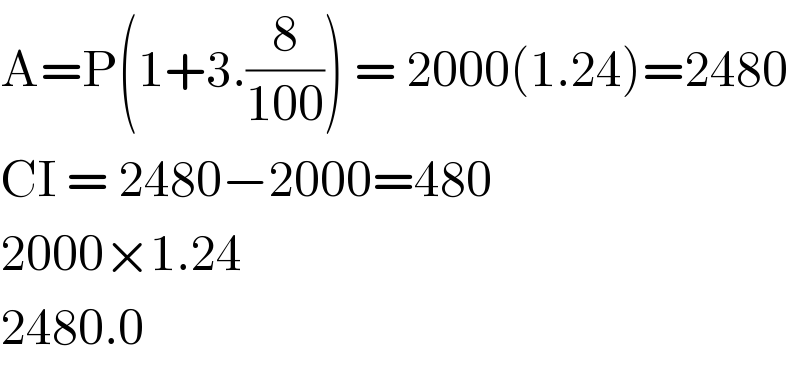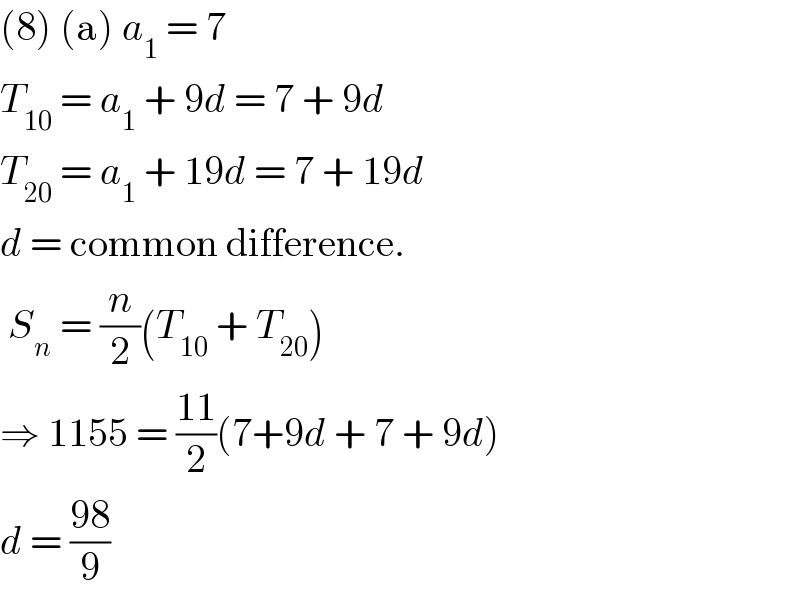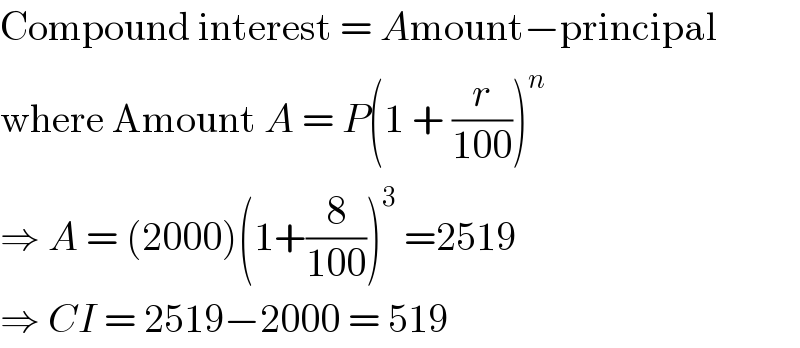Question Number 122514 by hedaru last updated on 17/Nov/20

Commented by liberty last updated on 18/Nov/20

$$\mathrm{A}=\mathrm{P}\left(\mathrm{1}+\mathrm{3}.\frac{\mathrm{8}}{\mathrm{100}}\right)\:=\:\mathrm{2000}\left(\mathrm{1}.\mathrm{24}\right)=\mathrm{2480} \\ $$$$\mathrm{CI}\:=\:\mathrm{2480}−\mathrm{2000}=\mathrm{480} \\ $$$$\mathrm{2000}×\mathrm{1}.\mathrm{24} \\ $$$$\mathrm{2480}.\mathrm{0} \\ $$
Answered by physicstutes last updated on 17/Nov/20

$$\left(\mathrm{8}\right)\:\left(\mathrm{a}\right)\:{a}_{\mathrm{1}} \:=\:\mathrm{7}\: \\ $$$${T}_{\mathrm{10}} \:=\:{a}_{\mathrm{1}} \:+\:\mathrm{9}{d}\:=\:\mathrm{7}\:+\:\mathrm{9}{d} \\ $$$${T}_{\mathrm{20}} \:=\:{a}_{\mathrm{1}} \:+\:\mathrm{19}{d}\:=\:\mathrm{7}\:+\:\mathrm{19}{d} \\ $$$${d}\:=\:\mathrm{common}\:\mathrm{difference}. \\ $$$$\:{S}_{{n}} \:=\:\frac{{n}}{\mathrm{2}}\left({T}_{\mathrm{10}} \:+\:{T}_{\mathrm{20}} \right) \\ $$$$\Rightarrow\:\mathrm{1155}\:=\:\frac{\mathrm{11}}{\mathrm{2}}\left(\mathrm{7}+\mathrm{9}{d}\:+\:\mathrm{7}\:+\:\mathrm{9}{d}\right) \\ $$$${d}\:=\:\frac{\mathrm{98}}{\mathrm{9}} \\ $$
Answered by physicstutes last updated on 17/Nov/20

$$\mathrm{Compound}\:\mathrm{interest}\:=\:{A}\mathrm{mount}−\mathrm{principal} \\ $$$$\mathrm{where}\:\mathrm{Amount}\:{A}\:=\:{P}\left(\mathrm{1}\:+\:\frac{{r}}{\mathrm{100}}\right)^{{n}} \\ $$$$\Rightarrow\:{A}\:=\:\left(\mathrm{2000}\right)\left(\mathrm{1}+\frac{\mathrm{8}}{\mathrm{100}}\right)^{\mathrm{3}} \:=\mathrm{2519} \\ $$$$\Rightarrow\:{CI}\:=\:\mathrm{2519}−\mathrm{2000}\:=\:\mathrm{519} \\ $$
